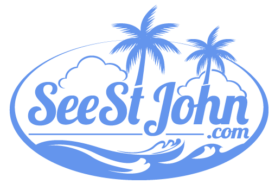The beaches of St. John, USVI, are widely considered to be among some of the best in the world by beach connoisseurs and travel professionals alike. The island of St. John is one of the loveliest, friendliest, and most beautiful places in the Caribbean. The climate is tropical but moderated by the ever-present trade winds.
The sand that carpets these St. John beaches is especially soft and powdery. It comes from the coral reef, making it finer than terrestrial sand that comes from the weathering of rocks. Since there are no rivers, large tides, or strong currents, the water is clear and clean, letting you see right to the bottom.
From just about any beach, one can enjoy a panorama of islands whose emerald green mountainsides rise from the clear blue Caribbean in the near distance. There is also a myriad of smaller cays, rocks, and bays.
Since most of the island is protected by the Virgin Islands National Park, the beaches are not overly developed, and you can always find a way to get away from it all and enjoy nature in its pristine state.
Here are some of our favorite and most popular beaches in St. John.
Maho Bay Beach
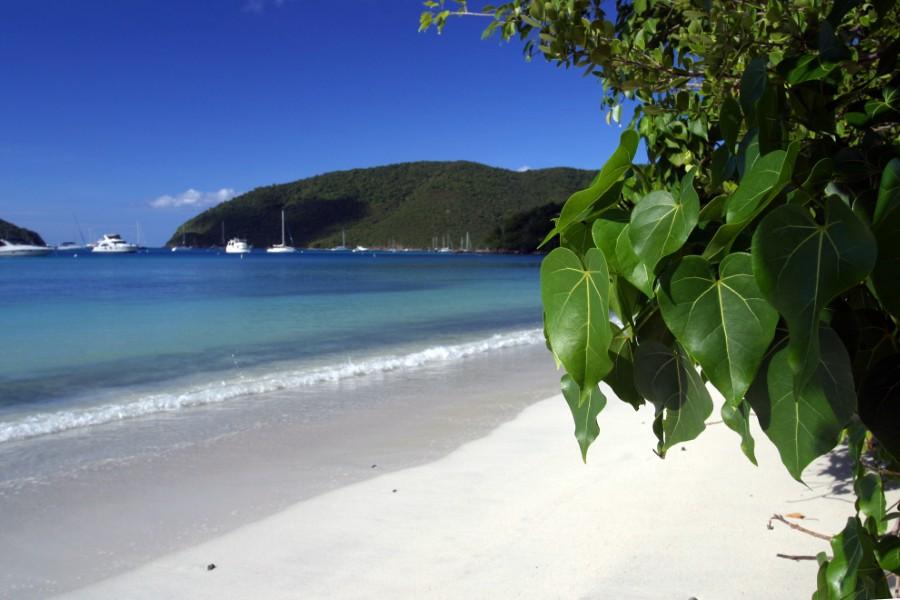
Maho Bay is generally one of the calmest north shore beaches and one of the top options for snorkeling with sea turtles. It’s a beautiful beach with stately groves of coconut palms lining both sides of the road. Parking can be found alongside the beach in the area of the pavilion or in the parking area on the other end of the beach.
Since Maho Bay Beach is calm and shallow, it’s a great place to bring the kids to get them used to the water or teach them how to swim and snorkel. It’s also a favorite destination for paddle boarding due to the tranquil waters.
In the summer, the genip tree by the side of the road produces some of the sweetest genips on St. John. The sea bottom is a mixture of soft sand and seagrass, where you can observe the creatures that inhabit this important environment, such as sea turtles, rays, all kinds of fish, and conch.
The shoreline on the southern coast of the bay provides an interesting area to explore. You can also walk along the rocky shoreline and fringing reef on the north. It goes out towards the campground at Little Maho Bay, which separates the two bays.
Trunk Bay Beach
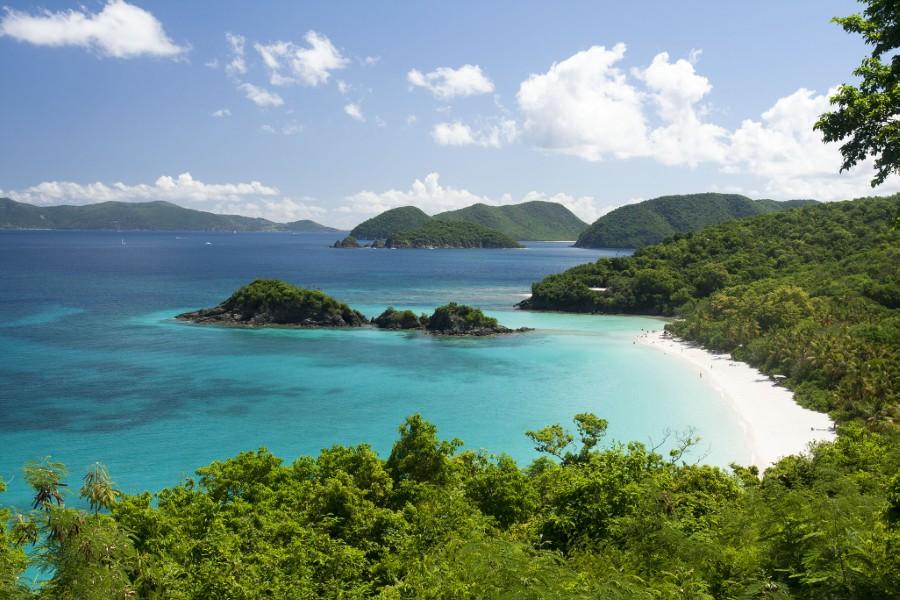
Trunk Bay has the most modern and convenient facilities and receives the most visitors of any beach on St. John. It’s a breathtakingly gorgeous beach, with perfect soft white powdery sand extending into the sea.
The beach is bordered by coconut palms, seagrapes, beach maho’s, and the lush tropical vegetation extending into the flat valley floor where the facilities are located. The turquoise and blue water is crystal-clear, and the panoramic view from the beach is picture-perfect.
Trunk Bay Beach is over a quarter-mile long with a spit of sand that juts out in the direction of Trunk Cay, giving the bay a heart-shaped appearance. Trunk Bay is three miles from Mongoose Junction, heading east on Route 20. You can find some beautiful villas that you can stay in near Trunk Bay Beach, so you’ll be right by the Virgin Islands National Park.
There is a parking lot, showers, bathrooms, and changing areas available. Plus, picnic tables, barbecue grills, and a covered pavilion. A gift shop provides just about everything you might need while at the beach, such as sunscreen, towels, and insect repellent. You can also rent lockers, snorkeling equipment, flotation devices, and beach chairs.
Trunk Bay is the home of the National Park’s underwater snorkeling trail, making it a must-see when you’re planning your list of activities to do in St John. It begins just offshore of the spit of land that juts out toward Trunk Cay and is marked by buoys.
The snorkeling trail consists of a series of underwater monuments with signs providing environmental information and identifying some of the flora and fauna common to the coral reef. Fish survey volunteers report that, on average, you should see 30 distinct species of fish in a half-hour snorkel of the Trunk Bay Underwater Trail.
Salomon Beach
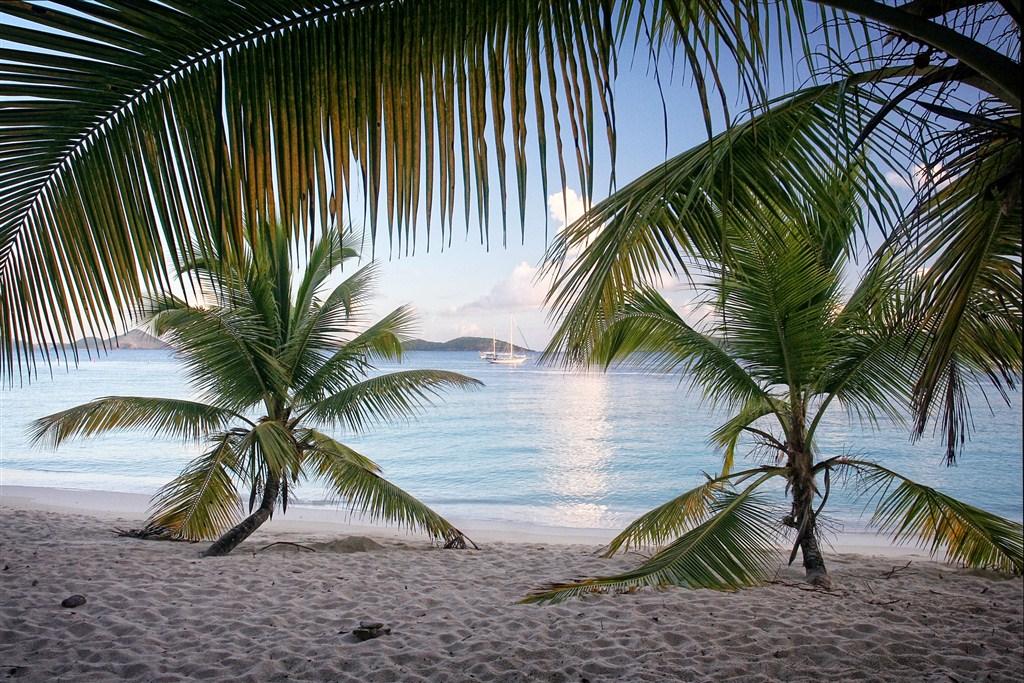
Traveling from west to east, Salomon Bay is the first of the north shore beaches. Depending on where you stay in St John, it might be a convenient and short drive if you’re resort is located in the main town of Great Cruz Bay.
To get to Salomon Bay, you’ll need to walk, swim, or arrive by boat. However, there are certain hikes in St John that will take you all the way to the beach that might be worth checking out if you’re up for it.
In fact, the most common way to arrive is via the Lind Point Trail, which begins just across from the National Park Visitors Center. Another alternative would be the Caneel Hill Spur Trail.
There are two beaches on Salomon Bay, separated by a rocky point of land. The furthest west (closer to Cruz Bay) is known as Salomon Beach. The Eastern Beach, closer to Caneel Bay, is known as Honeymoon Beach.
There are no facilities at Salomon Beach. This fact, in addition to the relative difficulty of arrival, makes Salomon less visited and more private than its neighbor to the east, Honeymoon Beach.
From both Salomon Bay and Honeymoon Bays, you can see most of the islands that define Pillsbury Sound. Looking from the west to the east, you will see St. Thomas, and Jost Van Dyke, one of the British Virgin Islands.
The coral reef community here is colorful and diverse. The fish are plentiful, and there is a great deal to see. This is the best-protected and most easily accessible shallow water snorkel in St. John, and it can be thoroughly enjoyed by snorkelers of all experience levels.
When snorkeling, you might notice several different varieties of fish swimming about, which are constantly on the lookout for tasty bottom dwellers. Snorkeling over the sandy bottom is also a good way for beginners to get practice before attempting to snorkel over the reef.
Honeymoon Beach
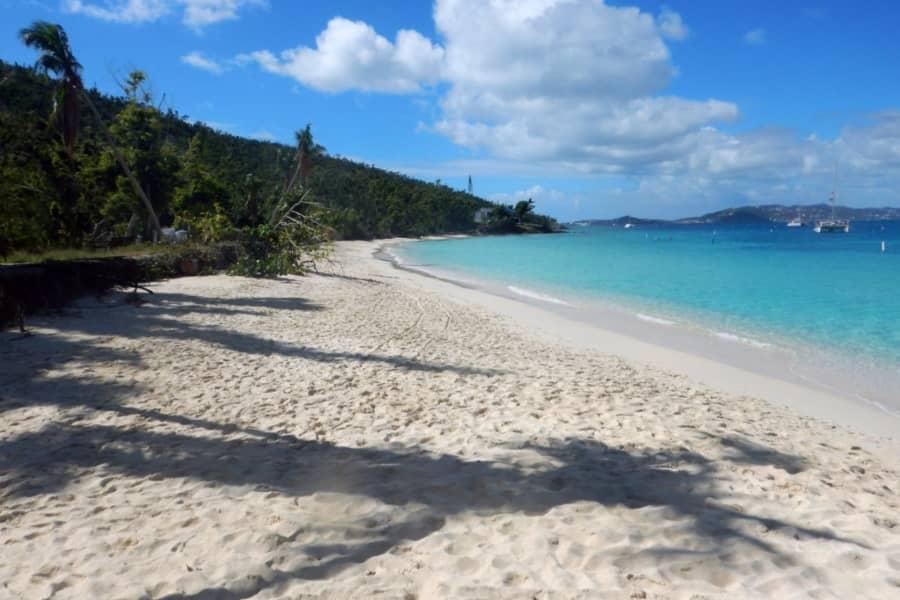
Honeymoon Beach is one of the most romantic beaches in the U.S. Virgin Islands. Snorkle near the west end of the beach to reach the coral reef in the area.
Facilities include restrooms, lockers, and a beach hut where you can rent beach chairs, snorkel equipment, kayaks, and standup paddleboards. Cold drinks, ice cream, and snacks are also available for purchase.
Like Salomon, there is no road to Honeymoon. You need to walk the trail or go by boat. Honeymoon Beach can be reached by taking the Lind Point Trail. It’s a little over a mile from Cruz Bay to Honeymoon. Follow the directions to Solomon Bay, but when you get to the Solomon Bay Spur, continue on the Lind Point Trail instead of turning left.
For the shortest walk (less than a half mile, with a descent of 250 feet) to Honeymoon Beach, take Route 20 past Mongoose Junction and up the hill. Turn left at the top of the hill, where there is a blue Virgin Islands National Park sign.
Immediately on the right-hand side is a parking area for approximately four vehicles, where you can park at. The Caneel Bay Resort (now closed) provides public land access to Caneel and Honeymoon Beaches. If you plan to stay at a hotel in Cruz Bay, St. John, you’re only a 10-minute drive from this beach.
Unlike the narrow forest trail that winds down a rocky hillside, the dirt road from the Caneel Bay parking lot is well-maintained, and there are no hills to climb. On your way to the beach, you can enjoy the magnificent landscaping that borders the road.
Gibney Beach
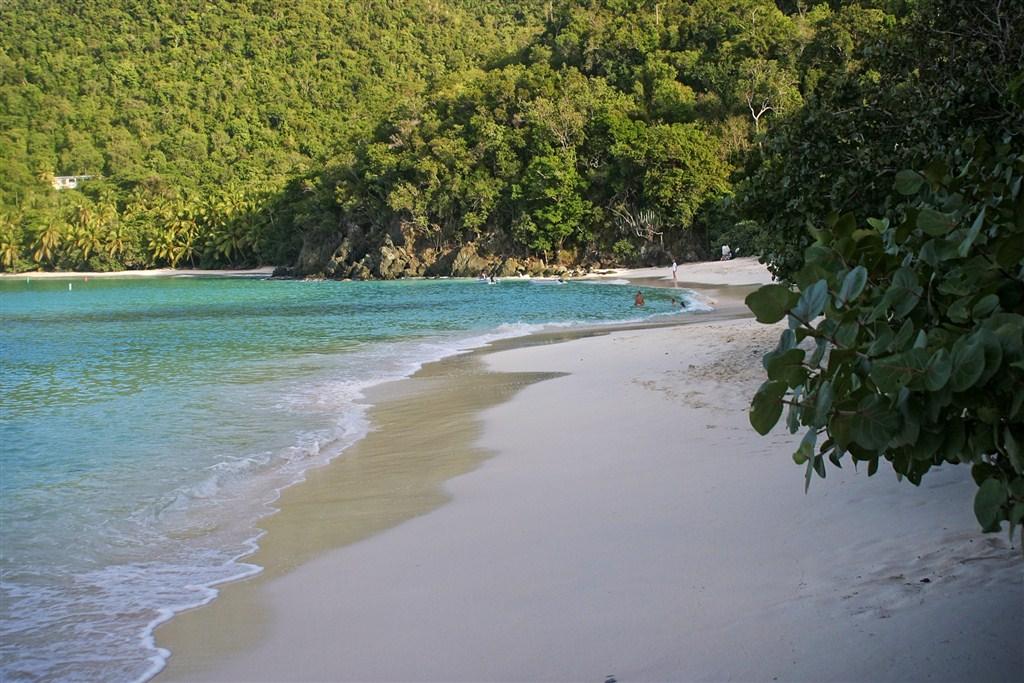
Gibney Beach is a great choice if you want a more secluded and private atmosphere. Gibney Beach is located on the northwest side of St. John, within the Virgin Islands National Park near the very popular Trunk Bay.
There are some fantastic opportunities for snorkeling and the nearby Oppenheimer Beach. Entering the water from sandy ground, you can quickly discover an environment teeming with life. You’ll see an abundance of elkhorn, fire corals, and a dazzling variety of native fish.
Yellowtail snapper and blue runners can be seen prowling around, looking for a quick meal. Be on the lookout for angelfish, squirrelfish, and trumpetfish, among the many others who call this and surrounding reefs home.
As with any reef, be careful not to touch or step on the coral structures, or you can damage them and possibly hurt yourself. This is a swim-at-your-own-risk location, so know your limits and abilities as a snorkeler and stay safe.
If you want just to kick back and relax, the soft sand and gentle coastal shore of Gibney Beach provide a perfect spot. It’s a quiet little slice of paradise where the hours pass easily.
Cinnamon Bay Beach
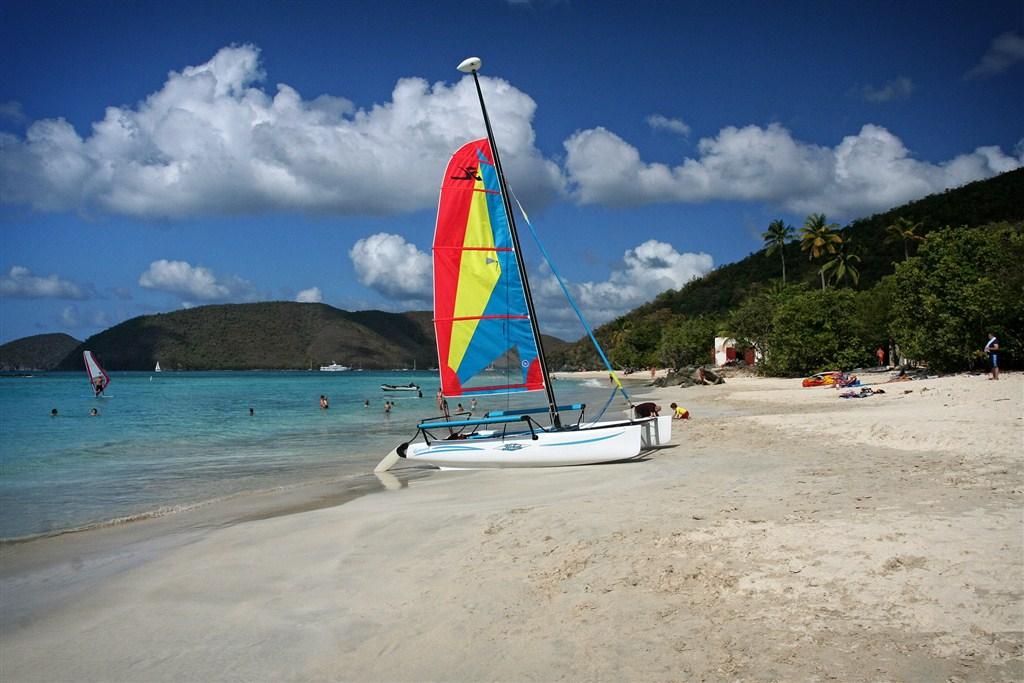
For a not-so-spicy stretch of white sand beach, check out Cinnamon Bay Beach, located on the northern shores of the Virgin Islands national park. With the longest stretch of open beach on the island, Cinnamon Bay Beach accommodates loads of beachgoers year-round.
It’s an excellent location for novice snorkelers with its shallow, see-through-blue waters and sandy bottom. You can stay close to the shore and check out some of the corals in the shallows, and the relatively calm waters are a breeze to navigate. The best spot for snorkeling is near the eastern end of the beach, where you can catch sight of green sea turtles.
If you’re feeling adventurous, take a short swim to Cinnamon Cay. Here you can find a rocky shore with coral as far as the eye can see. Hundreds of tropical fish species call this area home, and you’ll be able to see groupers, grunts, and so much more. There are even a few shark species that are known to frequent the area, so be on the lookout and keep a safe distance.
Take a break after all that snorkeling and relax in the shade of the palm trees on the beach or lay out and get some needed sun. There is plenty of space on Cinnamon Bay Beach to enjoy your day at whatever pace you see fit.
Leinster Bay/Waterlemon Cay
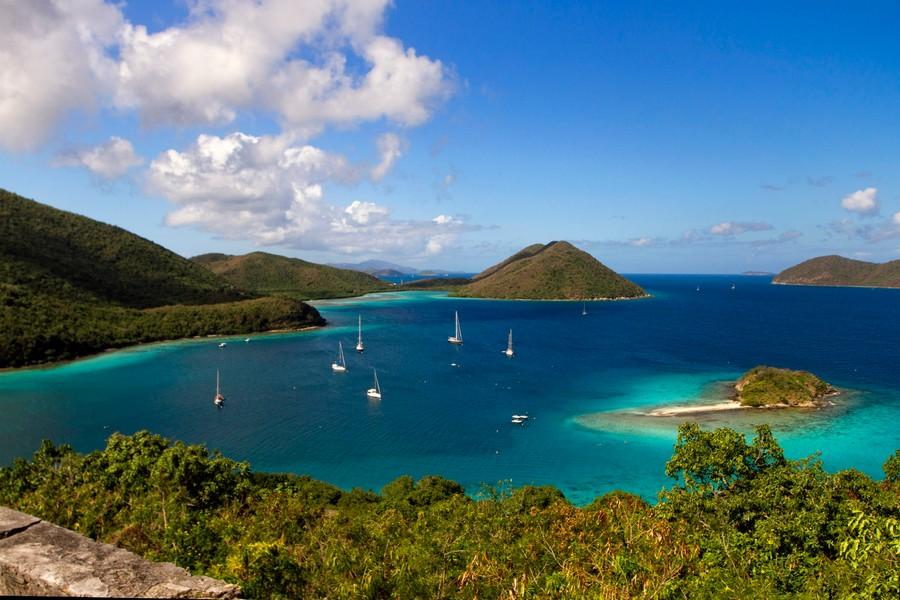
Leinster Bay offers snorkelers a quiet corner to enjoy the warm waters of this shallow bay in St John island. The location provides relatively calm seas year-round and can accommodate every swimmer’s skill level.
The sandy beaches meet with the many clear blues of the ocean as you dive in anywhere at Leinster Bay. You can see a variety of scattered reefs and fields of seagrass, home to the many tropical fish, coral, and rays that inhabit the waters. Head to Waterlemon Cay and check out the fringing reef perimeter that provides shelter to blue tangs, parrotfish, and the occasional green sea turtle.
Travelers can enjoy watersports like kayaking, paddle boarding, and observing marine life. Most of it is untouched wilderness, so it can be a nice escape from the resorts and packed beaches in Cruz Bay.
If you feel like taking a hike, there are some amazing hiking trails just off the bay with miles of beautiful scenery. You can try the Leinster Bay Trail or the Brown Bay Trail. They can provide a great view to scope out potential snorkeling spots of interest.
After hiking, hop on the beach for a quick cooldown. Waterlemon Cay can provide the perfect location for fun days of sand, sun, and snorkeling.
Haulover Bay (North)

Haulover Bay sits on the far eastern side of St. John, just outside the bounds of the Virgin Islands National park. The rocky shore here is filled with millions of coral, and the shallow waters nearby provide an excellent environment for snorkeling.
Be careful where you dive in since, unlike some other spots around the island, this area is more loose stone and coral than sand. Haulover Bay is quite remote, so there won’t be near as many tourists.
You get to see the full display of different types of coral native to the U.S. Virgin Islands. There are loads of sea urchins near the shore, so be very careful as you step. If you move out into the seagrass beds near the middle of the beach, you can see stingrays and sea turtles feeding.
Since Haulover Bay is just outside the national park, it’s free to visit, and there are even a few parking options nearby if you’re driving around with a rental car. This is an unsupervised location, so check the water and weather conditions before heading out for a swim.
Francis Bay
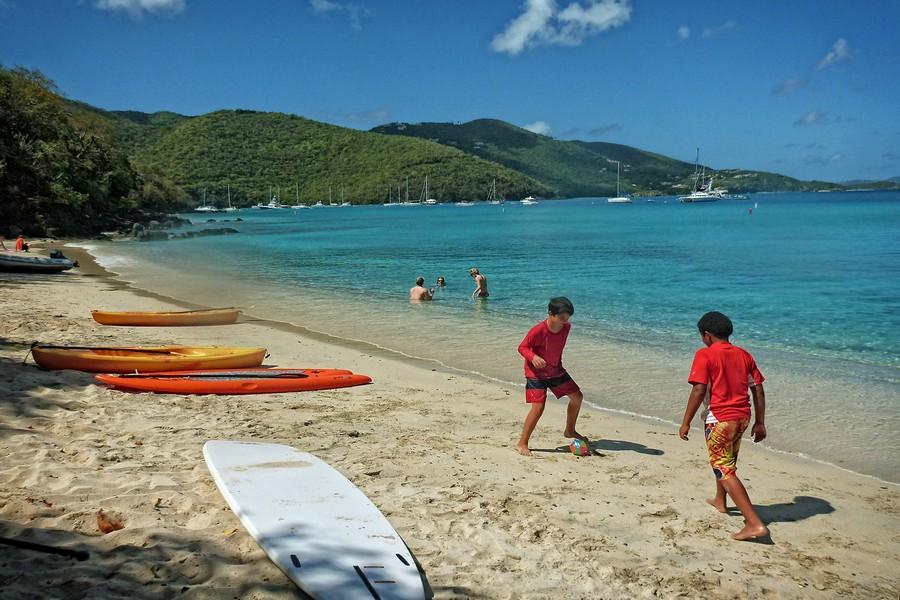
One of the largest stretches of open beach is located in Francis Bay. Whether you’re looking for a relaxing day in the warm sand alongside other beachgoers or a private retreat to get away from it all, there is plenty of space to go around.
This snorkeling spot is second to none when visiting St. John. Every marine animal you might imagine in the Caribbean hangs out in this area. Spot an octopus hunting in the rocks, or watch sea turtles easily fly through the water. Swim through endless schools of fry or French grunts, and see solid underwater clouds made of fish.
Where the schools are, you’ll also find much larger fish who rush in to scoop up a quick bite. Keep an eye out for yellowtail snappers, barracudas, and tarpons as you get into deeper waters near the seagrass beds.
It’s a great beach to bring kids to but it’s pretty popular, so be sure to head out early and claim your little piece of paradise for the day.
Hansen Bay Beach
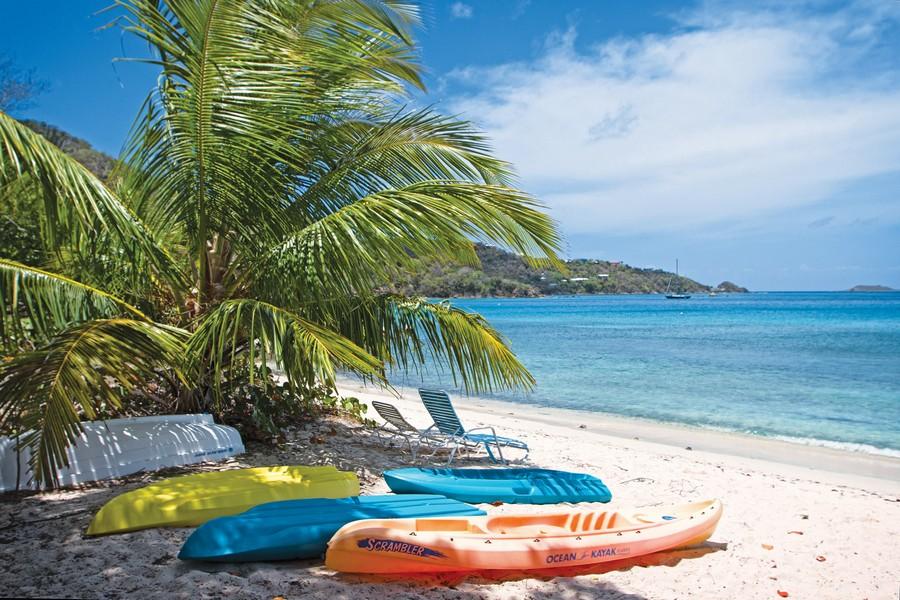
You can find Hansen Bay Beach near the most eastern side of the island, close to Coral Bay. It’s favored among the locals and has beautiful crystal clear waters and white sand.
Its calm waters offer an assortment of sea life, which includes colorful fish and an plenty of coral. There is a lot of seagrass, which means you can find many sea turtles and rays.
Parking is available if you’re driving a car but be nice as it’s private property and the owner maintains it through donations. In the past, you could find a shack that sold a variety of things that has recently been closed. Just make sure to take everything you may need for a beach day if you plan on visiting Hansen Bay Beach.
If you’re feeling adventurous, you could also kayak or paddle all the way to the Limeout VI restaurant across the bay and enjoy some delicious sea tacos.
Klein Bay
Klein Bay is a cobblestone beach where one can delight in the colorful polished stones and beautiful pieces of bleached white coral that make up large ports of it. They extend into the water along the shoreline for about twenty feet and up to a depth of about three feet.
The bottom then changes to one of larger rocks and reef for about another twenty feet before becoming the sand and grass bottom that characterizes the majority of the bay.
To get to Klein Bay, start at the roundabout in Cruz Bay and take Route 104 east 1.6 miles. When the road forks, bear right and continue following the south shore coastline. Make the first right turn onto the road, which leads to Klein Bay.
Make the second right turn and park at the end of the road, where a short path leads to the beach. Although the access road is private, no attempts have been made to restrict public access to the beach.
Although the entrance into the water is a bit difficult, the swimming is good. Enter between the center and the eastern portion of the beach. It’s safe to walk on the pebble bottom. When that ends, swim or snorkel over the area of larger rocks to avoid the sea urchins.
There is good snorkeling along the rocks on both sides of the bay. The underwater grasslands may also hold pleasant surprises for patient snorkelers. Look for conch, turtles, and spotted eagle rays.
Denis Bay
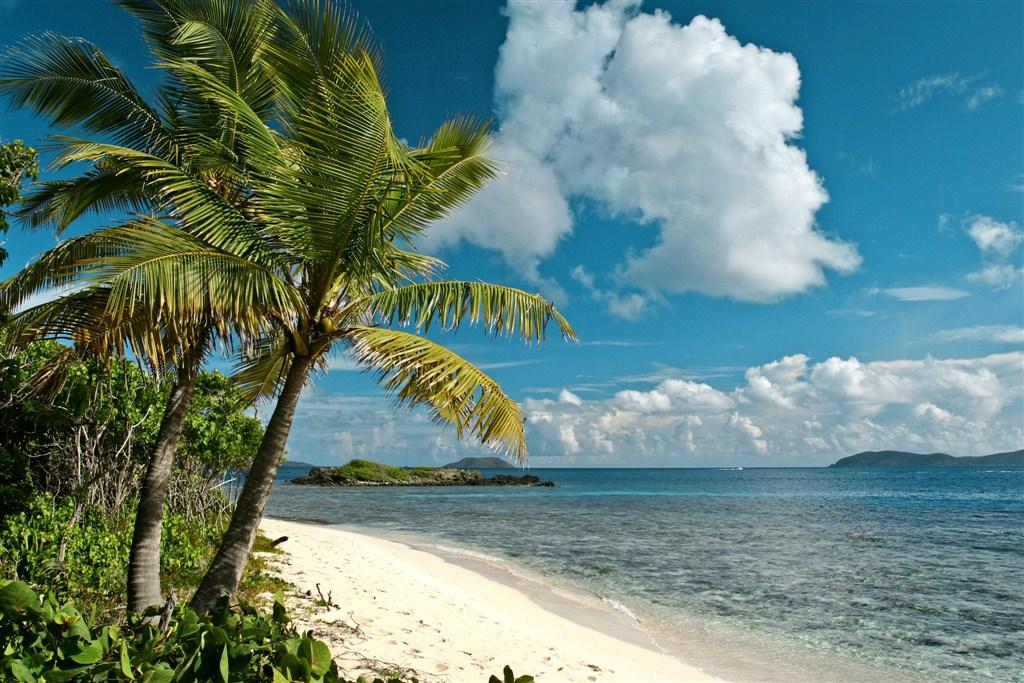
Denis Bay is quiet and secluded beach, but you will need to be adventurous to get there, as you need to arrive by sea or via a rugged trail through the forest.
Look for the narrow path that begins near the bottom of the Peace Hill Trail. The path descends to a secluded section of beach on the western extreme of the bay. The little island just offshore is Perkins Cay. You won’t find any facilities here.
Denis Bay is now part of the Virgin Islands National Park, but the structures and some of the land behind the beach have been leased to private interests. Please confine your visit to the area between the sea and the line of first vegetation.
The bay is well protected by extensive fringing reefs. From the sea, there is an open channel leading to the center of the beach, where there used to be a dock.
When the seas are calm, there is decent snorkeling around the reef, especially on its seaward side and around Perkins Cay. Snorkeling about ten yards offshore of the east side of the remains of the old dock, you can see the coral-encrusted fluke of a very large and very old anchor protruding from the sand.
Lameshur Bay Beach
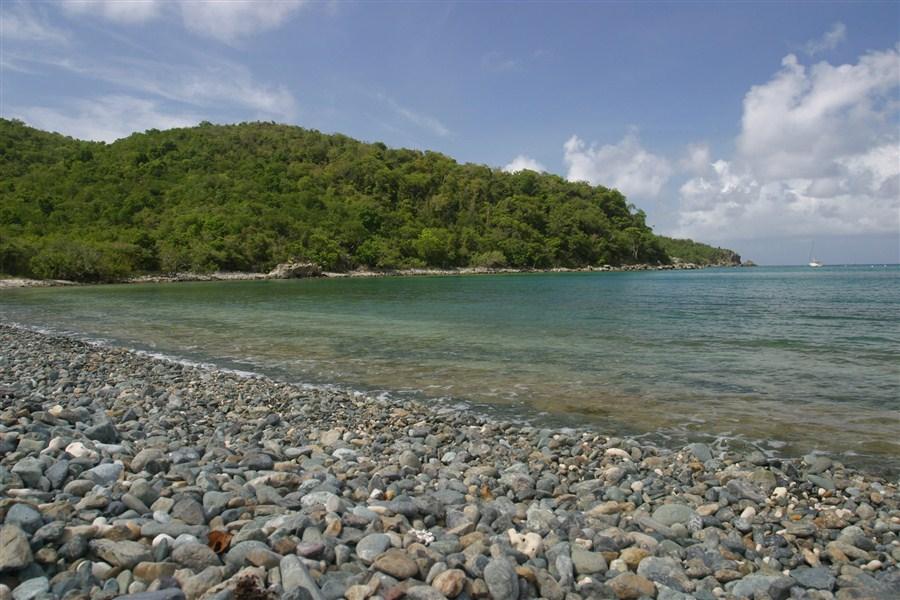
Lameshur Bay is an excellent alternative to north shore beaches, especially on days when winter swells might make swimming and snorkeling on the north uncomfortable. Facilities are limited to picnic tables, barbecues, and toilets.
Lameshur Bay is further away and harder to drive to than Salt Pond Bay. It involves a difficult and steep section of road, but unlike Salt Pond Bay beach, it’s conveniently located right next to the parking area. At the end of Route 107, traveling south, continue one mile on the dirt road. You can park anywhere along the road in the vicinity of the beach.
Lameshur Beach is also a perfect place to take a refreshing dip in the sea after exploring the nearby ruins or taking a hike on the Lameshur Bay or Bordeaux Mountain Trail.
Beginners can snorkel around the rocks just off the beach. On calm days, the east side of the bay leading towards Europa Bay offers advanced snorkelers steep cliffs, and canyons often teaming with fish. Lameshur Bay is also the gateway to Yawzi Point, an awesome snorkeling spot.
Reef Bay
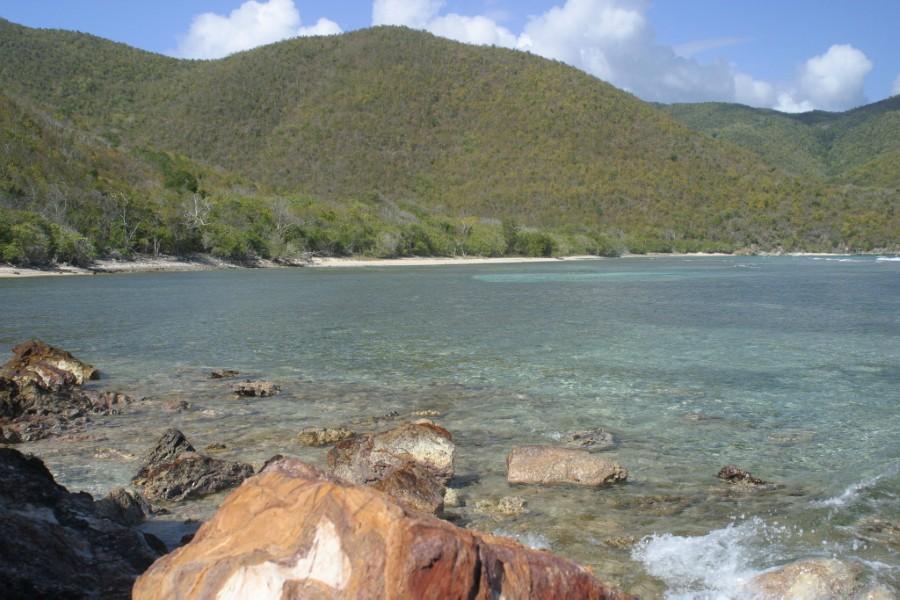
Reef Bay consists of three inner bays, Genti, at the end of the Reef Bay Trail, Little Reef Bay, and Parrot Bay on the west. The best place for swimming in Reef Bay is at the eastern end of Little Reef Bay, near the rocks along the eastern shore, so to your left if you’re looking out to sea.
The beach at Genti Bay is a good place to cool off after the long hike that you just took in order to get there. The beach is sandy, but the sea bottom consists of grass and patches of coral. Be careful getting into the water, as small sea urchins may be hidden between rocks or pieces of coral. It lies at the end of the Reef Bay Trail near the remains of the old sugar mill.
Little Reef Bay features soft coral sand. As you enter the water, the sea bottom consists of sand and seagrass. The water is deeper, and the bottom is sandier and more comfortable than the beaches at either Parrot Bay or Genti Bay.
Another plus is the almost guaranteed privacy afforded by the remote location. To get to Little Reef Bay, you’ll need to take the spur trail from the bottom of the Reef Bay Trail or walk along the Reef Bay coast from Parrot Bay.
Parrot Bay beach consists of soft white sand mixed with pieces of coral. There are scattered coral heads just offshore. There is usually breaking surf, making it ideal for surfing but not so good for swimming or snorkeling. Except for the westernmost extreme of the beach, there is a solid line of reef about twenty yards offshore that creates a shallow lagoon between the ocean and the beach.
Along the shoreline, there are several patches of sand that jut into the vegetation providing a measure of privacy and offering seclusion for sunbathing and picnicking.
Hawksnest Beach
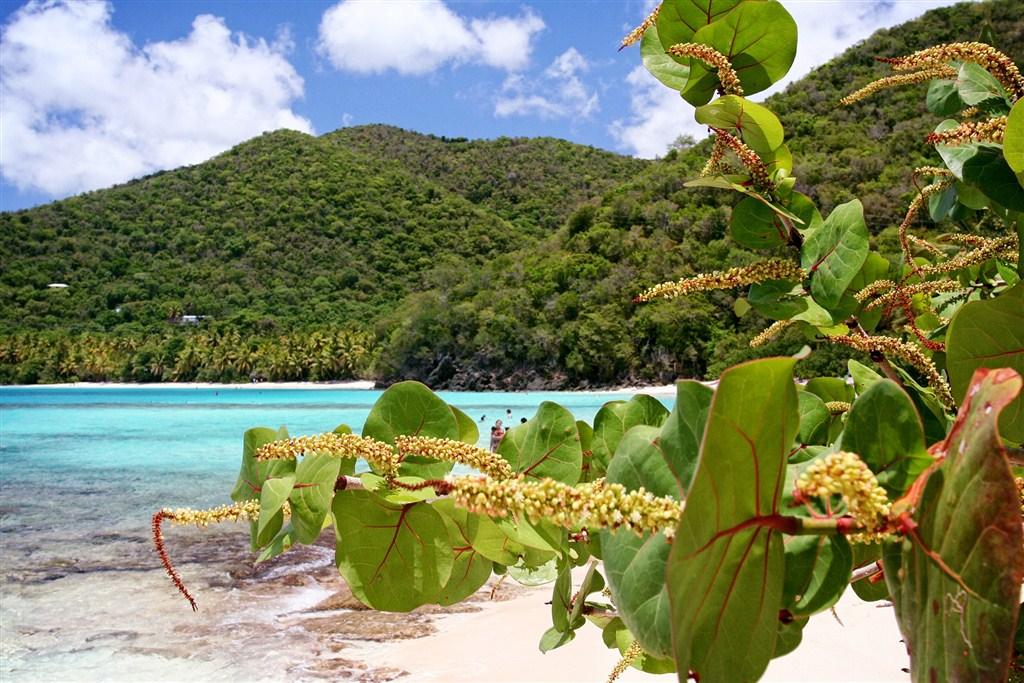
Hawksnest Bay Beach is a St. John locals’ favorite and the preferred beach for families with children. Hawksnest Beach is not only one of the most beautiful beaches on St. John, it’s also quite convenient.
It’s a close drive from Cruz Bay, and the parking lot is closeby, so there’s no need for a long walk carrying your belongings. In the late afternoon, many locals come to take a soak after work.
To get to Hawksnest Bay, start from Mongoose Junction, go 1.8 miles east on route 20. Hawksnest Bay Beach provides ample parking. Some weekends, especially when a popular holiday brings more people out, it may be somewhat tight.
There are pit toilets but no running water, thus no showers, sinks, or flushing toilets. Between the parking area and the beach is a shady wooded area. There are two pavilions (covered decks with tables) that are often used by groups. Uncovered picnic tables and barbecue grills are also available.
Hawksnest Bay faces east and is lit by the St. John morning sun, so if you enjoy a refreshing swim in the early morning light, this is the right beach for you. The bay gets shade earlier in the afternoon than other beaches.
